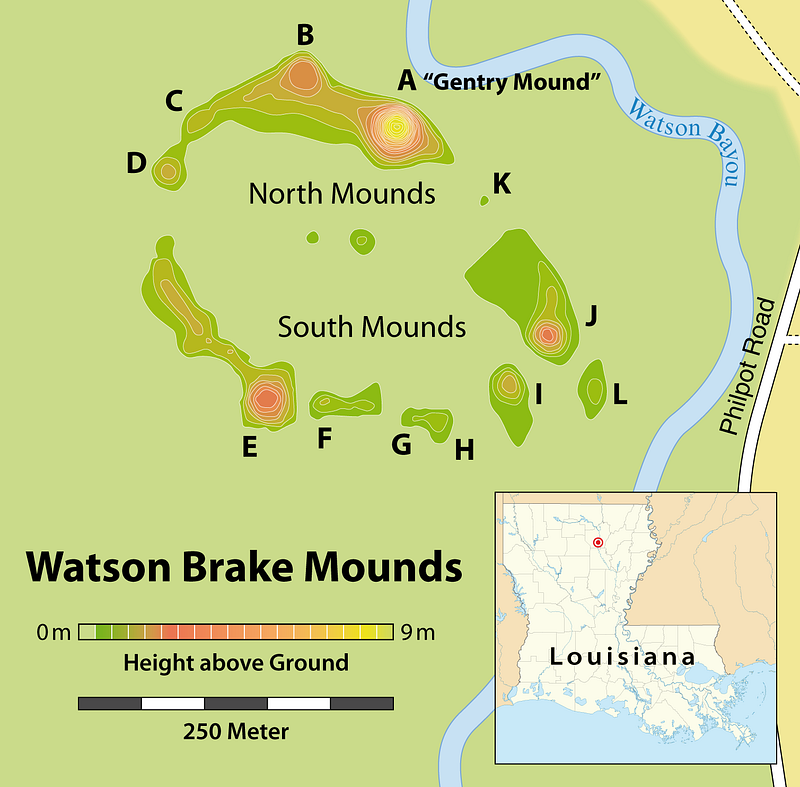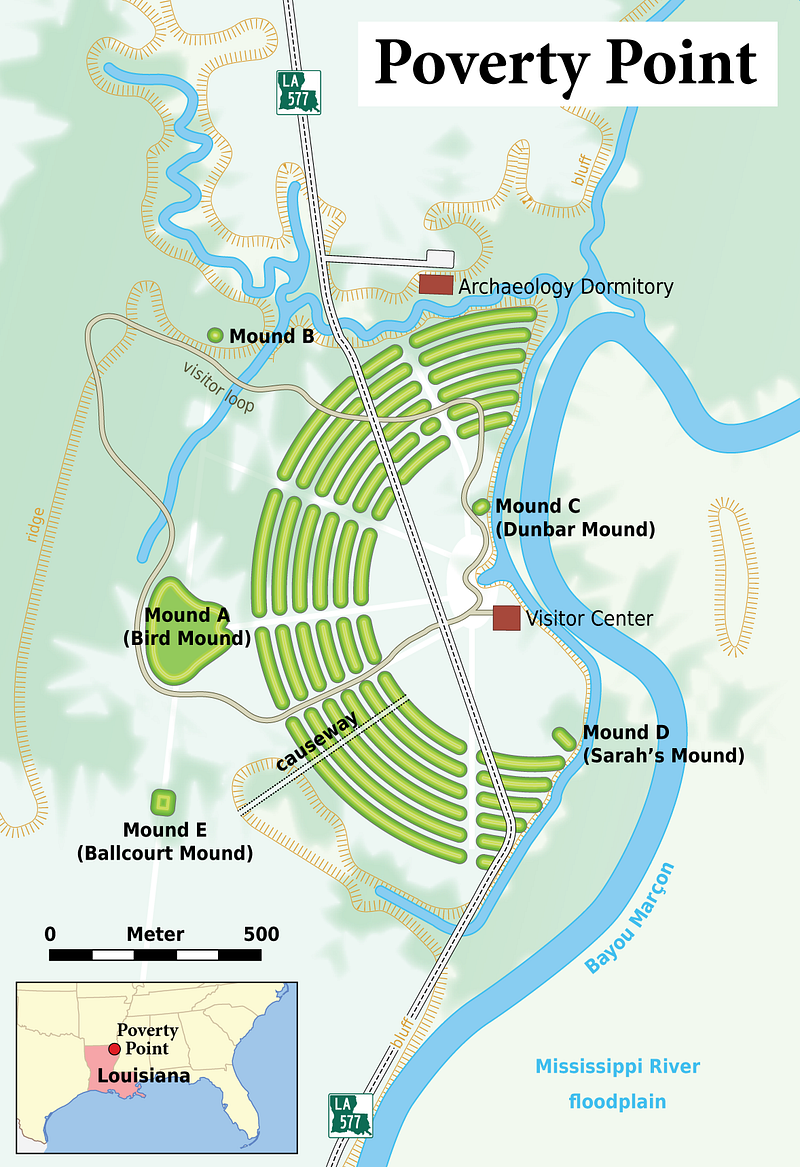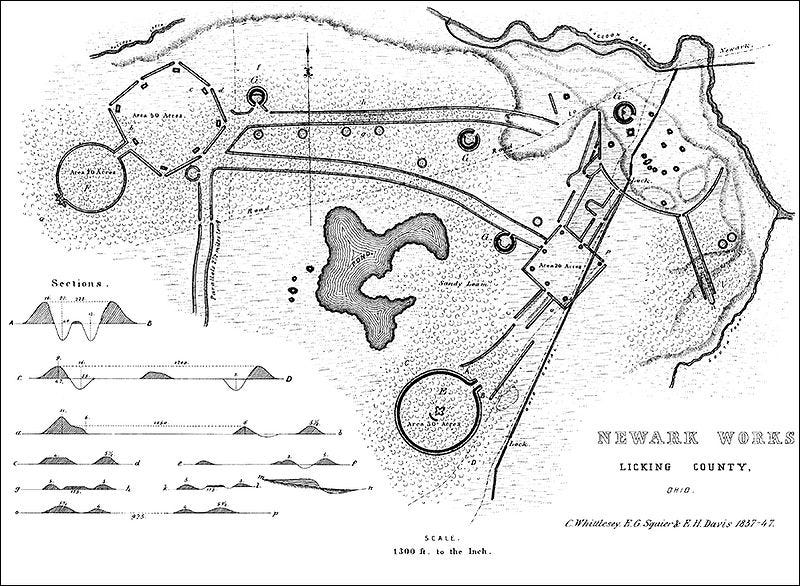Echoes of the past reverberate around us, calling out for secrets to be told.

The Ancient Past surrounds us in North America like an unspoken, open secret. Speaking it, however, may require too much revision of the tales and legends we tell ourselves of our taming the “New World” — for it is seldom mentioned. But both honesty and history demand a reevaluation and a retelling, all the same. For the echoes of the ancient past call out for a hearing, and stir us to discovery.
What is this secret laid out all around us, in the open? When many consider ancient ruins remaining from antiquity, mysterious sites which yield clues to vanished civilizations, the Pyramids of Egypt built circa 2500 BC may come to mind, or perhaps Stonehenge in Great Britain, built around 2600 BC.[i] Yet many remain unaware of ancient sites here in North America which predate or are contemporary with these better known ancient wonders.

Have you heard about the impressive circle of mounds, found at Watson Brake, Louisiana, which predate both Stonehenge and the Pyramids? They go all the way back to about 3400 BC.[ii] Built by hunter-gatherers, whom we didn’t used to consider capable of such behavior. One of the earliest such sites in North America.
What about nearby Poverty Point, Louisiana, an even more elaborate arrangement of mounds which dates to about 1500 BC[iii]? This geometric arrangement of arced mounds and the large Eagle or bird effigy mound, also shows a much more complex and religious society than once theorized.


From those very earliest sites, Ancient North Americans, the ancestors of those later mis-labeled “Indians” by Columbus and those who followed, spread north into the middle of Eastern North America, leaving burial, ceremonial and effigy mounds, and other geometric and adapted natural formations in their wake across the area, over thousands of years.
Are you familiar with the Great Serpent Mound, or the giant geometric earthworks found in Marietta and Newark, Ohio? [iv]

Were you aware that, prior to the arrival of Europeans, there were Native American cities dotted with huge mounds that rivaled contemporary London[v] in size and population? At Cahokia, in Illinois, the largest prehistoric site in the United States, just east of modern St. Louis, a giant earthen mound or pyramid with a base footprint larger than that of Egypt’s Great Pyramid, still proudly marks the spot where such a city thrived until about 1400 AD.[vi]

Their society had more in common with Egypt under the Pharaohs than it did the nomadic tribes of the West. Conservative population estimates place several thousand people there at its peak, but some estimate a population of ten, even twenty thousand.[vii]
Yet, we hear nothing of this ancient past, laid out around us like an open secret.
Ignorance, prejudice and racism cloud our views of the early history of this land we call North America.
Europeans landed with increasing frequency in the so-called “New World” from Columbus’ time forward, carrying with them myriad diseases not previously encountered by Native Americans, including deadly smallpox. These diseases devastated native populations — by some estimations, they were killed by the millions: “Within just a few generations, the continents of the Americas were virtually emptied of their native inhabitants — some academics estimate that approximately 20 million people may have died in the years following the European invasion — up to 95% of the population of the Americas.”[viii]
For a culture based on oral traditions, this sudden devastation had an unfortunate cultural impact — the surviving descendants suffered a kind of cultural amnesia, forgetting their people’s pasts.
When later European-American explorers began venturing beyond the coasts, they found monumental earthworks, ceremonial mounds, and expansive geometric earthworks. But many of the surviving Native Americans no longer knew who had built these places. That knowledge had been taken from them through disease, and death.
And if they had claimed their ancestors had built them? Would they have been believed? In the late 18th and most of the 19th century, many non-native Americans of European descent decided the “savages” they found in small bands in the wilderness could never have built the giant earthworks they were finding.
Instead, legends grew of a race of “Moundbuilders” who were variously described as a Lost Tribe of Israel, wandering Celts, or any number of other non-Native explorers, who had found their way to America in the distant past, built mounds, and who were, eventually, killed off by the so-called Savages.[ix]
The mounds were said to be their lost legacy, the craft-worked remains found alongside human bones held up as alleged “proof” of many speculative theories. At times, con-men and charlatans were exposed for burying and helping to “discover” faked relics in mounds, marked with Runes, or ancient Hebrew.[x]
Even so, many European settlers had no regard for the past except as a curiosity, and no use for what might be ancient ruins, save as raw materials for building their own new settlements. Racism and prejudice, coupled with the idea that this was a “New World” with which the new invading settlers could do with as they pleased — as they had a divine “Manifest Destiny” to do so — led to wholesale destruction of many sites. Mounds were looted for “treasure” and destroyed for use as fill.[xi]
This ignorant destruction continued into the 21st century, even as we learned how valuable these sites could be to understanding the ancient history of this land. Retail giant Walmart has a sad past record of destroying ancient mounds to build new superstores and Sam’s Clubs.[xii] Mound sites are often the last open parcel of land in a population growth center. Left unpreserved, they often fall prey to unscrupulous or, at best unsentimental, developers.
Archaeology began appreciating these sites in the nineteenth century, and as the twentieth ran into the Great Depression, the resulting New Deal saw many new government programs pour dollars into digging up these sites, and we learned a great deal. Ironically, as academic interest waxed, public interest waned. No longer thought of as the remnants of some mysterious lost — white — race, but now known to be the heritage of Native Americans, interest in the earthworks and ruins flagged.
Even today, new or increased interest in these sites is often stirred by fringe archaeological theories or ideas deemed pseudo-archaeology by mainstream scholars, and not by the incredible nature of the finds themselves in their own right. The “what if?” factor of sensational claims creates a sense of mystery that engages the general public’s curiosity, usually to the consternation of academia. Those dedicated to preserving the sites tend to be less circumspect in their judgements, allowing that any interest is welcome which helps preserve the site itself.
The pragmatic nodding and smiling of site guides as tourists proffer their theories of exploring Knights Templar, wandering Celts, ancient aliens, or lost tribes of Jews, may strike academics as overindulging their fantasies, but such fictions at least stoke an interest in keeping the sites themselves from being destroyed. In the best cases, those who delve deeper may discover the truth itself to be more fascinating than idle speculations on outsider explorations.
Truth is… it is fascinating! There is ancient history all around us, but we tend to be culturally monolithic and nearsighted, and so don’t see it for what it is. We are unconsciously conditioned by our society’s historical racism and ignorance. Like those who first found the mounds in the past, most of us still have a hard time conceiving of impressive accomplishments by ancient Native Americans.
We should be more aware of the ancient, open secret around us. Visit the sites — there are great guides for trips to the ones open to the public.[xiii] And instead of casting your vision across the seas as you gaze into the ancient past, focus your sights here. After all, Cahokia and Poverty Point are now two of the few places designated World Heritage Cultural Sites by the United Nations in the U.S. — putting them in the company of China’s Forbidden City, the Colosseum in Rome, Machu Pichu… Stonehenge and the Pyramids of Egypt.[xiv]
Echoes of the ancient past reverberate all around us, calling out for their secrets to be told.
Mike Luoma is a writer, podcaster, audio book narrator, comic book creator, and publisher from Vermont. His work can be found at http://glowinthedarkradio.com.
[i] These are the commonly held, mainstream dates assumed for construction of these sites. For one example, see A Historical Timeline: https://www.travel-ancient-world-sites.com/Historical-Timeline.html.
[ii] The Moundbuilders; Ancient Peoples of Eastern North America, by George R. Milner. Thames & Hudson, 2004. P. 48.
[iii] Ibid. p. 44.
[iv] Ibid, pp. 73–80.
[v] For reference, in 1086 the Domesday Book places London’s population at about 18,000. From A History Of English Population, By Tim Lambert. http://www.localhistories.org/population.html.
[vi] Ibid, p. 135.
[vii] Ancient America: Fifty Archaeological Sites to See for Yourself, by Kenneth L. Feder. Rowman & Littlefield, 2017. P. 55.
[viii] From the accompanying PBS site on the Jared Diamond book. Guns, Germs and Steel: Variables: Smallpox: https://www.pbs.org/gunsgermssteel/variables/smallpox.html.
[ix] The Moundbuilders, by Robert Silverberg. Ohio University Press (Reprint) 1986, Text 1970. P.74.
[x] Ibid, pp. 99–124.
[xi] Milner, pp. 7–8.
[xii] Wal-Mart’s history of destroying sacred sites, by Sue Sturgis. Facing South, September 3, 2009. https://www.facingsouth.org/2009/09/wal-marts-history-of-destroying-sacred-sites.html.
[xiii] Such as Ken Feder’s recent Ancient America: Fifty Archaeological Sites to See for Yourself, above. Also noteworthy is Feder’s new follow-up, Archaeological Oddities: A Field Guide to Forty Claims…, also from Rowman & Littlefield, 2019. While the author doesn’t always agree with Feder’s interpretations, the guides are very helpful and fun.
[xiv] Feder, Ancient America p. 57. This is almost a quote. Feder is an eloquent promoter of Cahokia.



